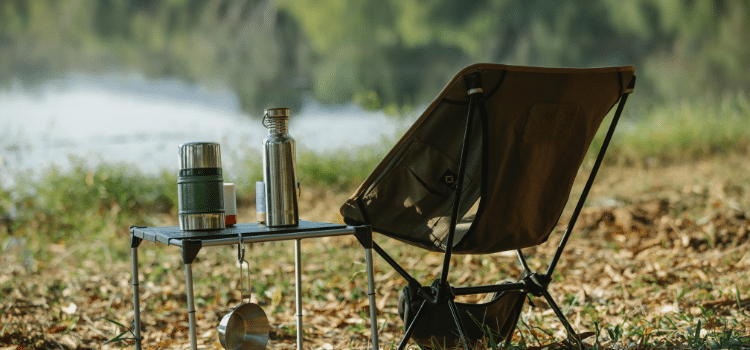Are you bored with your camp chair sinking into the ground and ruining your outside enjoyment? We’ve all been there. There’s nothing more frustrating than looking to relax across the campfire, most effective to find yourself sinking into the gentle earth below you. But fear no longer! we can propose a few realistic guidelines and hints on how to keep camp chair from sinking. By following those easy suggestions, you could ensure a strong and comfortable seating association at some stage in your outside adventures.
When it involves camping and outdoor activities, a reliable and comfortable camp chair is vital. However, sinking trouble may be a common trouble, especially on gentle and uneven terrain. Fortunately, there are several effective solutions to keep your camp chair solid and stable.
Choosing the Right Camp Chair
Investing in a high-quality camp chair is the first step in preventing sinking problems. Look for chairs specifically designed for outdoor use, featuring sturdy constructions that can withstand the rigors of nature. Consider upgrading to chairs with wider foot caps or adjustable feet for enhanced stability on different terrains.
Upgrade your outdoor seating game with camp chairs boasting wider foot caps, designed to defy sinking into soft terrains. These chairs offer enhanced stability, distributing weight evenly across their broader bases. Enjoy peace of mind knowing your camp chair stays steadfast, even on sandy beaches or muddy campsites. Look for this feature when selecting your next outdoor companion for a worry-free camping experience.
Customize your seating stability with camp chairs featuring adjustable feet, a versatile solution for varied outdoor landscapes. These chairs empower you to adapt to changing terrains, ensuring a solid seating platform wherever your adventures take you. With adjustable feet, you can effortlessly level your chair on uneven ground, from rocky trails to grassy meadows. Elevate your comfort and convenience by opting for chairs with this invaluable feature.
Understanding the Problem
Before we dive into the solutions, it’s important to understand why camp chairs sink in the first place. The sinking occurs due to the pressure exerted by the chair’s legs on the ground. If the legs are too narrow or don’t distribute the weight evenly, they can easily sink into soft surfaces like sand or wet soil.
Using Chair Leg Extensions
Leg extensions are a practical accessory that can prevent sinking. These extensions attach to the chair’s legs, increasing their surface area and distributing the weight more evenly. They are particularly useful for camping on sandy or muddy terrains.
Creating a Stable Base
If you don’t have leg extensions or prefer not to use them, you can create a stable base for your camp chair. Place flat objects like small boards or square footpads beneath each leg. This helps to distribute the weight and prevent sinking.
Fortify your camp chair against sinking and instability with leg reinforcements, a practical addition for rugged outdoor excursions. By attaching sturdy materials like PVC pipes or metal tubing to the chair’s legs, you enhance its structural integrity and resilience. DIY leg reinforcements offer a cost-effective solution, allowing you to craft custom supports tailored to your chair’s specific needs. Say goodbye to wobbles and sinking and hello to uninterrupted outdoor relaxation with this simple yet effective strategy.
Utilizing Stable Surfaces
Choosing a stable surface for your camp chair is another effective strategy. Look for firm ground, such as gravel or compacted dirt, as it provides better support and minimizes sinking. Avoid placing your chair on soft ground, like sand or loose soil.
Using Ground Protection
In situations where stable surfaces are scarce, using ground safety can make a significant distinction. Lay down a tarp, door mat, or maybe a chunk of plywood to create a strong barrier between your chair and the floor. This prevents the legs from sinking into the soft surface.
Spreading the Load
To further distribute the weight and reduce sinking, encourage campers to avoid placing all their weight on the chair’s back legs. Sitting more toward the center or front of the chair helps to evenly distribute the load and minimize sinking issues.
Regular Maintenance and Care
Proper maintenance and care can extend the lifespan of your camp chair. Check the condition of the chair’s feet regularly and replace them if they show signs of damage or wear. Additionally, keep your chair clean and free from dirt and debris that could affect its stability.
Extend the lifespan of your beloved camp chair with regular leg reinforcement, a proactive measure to preserve its stability and durability. By inspecting and reinforcing the legs at key junctions, you mitigate the risk of wear and tear, ensuring your chair remains sturdy and reliable trip after trip. Prioritize proper maintenance to safeguard your investment and enjoy countless hours of comfortable outdoor seating for years to come.
Conclusion
A sinking camp chair can quickly dampen your outdoor experience, but with the right strategies, you can enjoy a stable and comfortable seating arrangement. By choosing the right camp chair, using leg extensions or creating a stable base, utilizing stable surfaces, employing ground protection, spreading the load, and maintaining your chair, you can keep your camp chair from sinking and make the most of your outdoor adventures.
We have explored various methods to prevent your camp chair from sinking into the ground. By selecting the right chair, using leg extensions or creating a stable base, utilizing stable surfaces, employing ground protection, spreading the load, and maintaining your chair, you can ensure a comfortable seating experience during your outdoor adventures. So go ahead, enjoy nature, and keep your camp chair steady!
You May Like This:
- CAN CAMPING CHAIRS GET WET OVERNIGHT?
- 15 EPIC RAINY DAY CAMPING ACTIVITIES FOR ADULTS
- Fun Things ToTake Camping With Friends
FAQs
-
How do I choose the right camp chair?
Look for chairs with wide feet or adjustable leg extensions for added stability.
-
Are leg extensions necessary to prevent sinking?
Leg extensions are not necessary but can be helpful, especially on soft terrains.
-
Can I use my camp chair on the beach?
It’s best to avoid using camp chairs on sandy beaches as they tend to sink. Consider using a beach chair designed for that purpose.
-
How often should I check my chair’s feet for wear and tear?
It’s recommended to check the condition of the chair’s feet before each camping trip and replace them if needed.
-
Can I use any flat object as a base for my camp chair?
Yes, as long as the object is sturdy and can provide a stable surface for the chair.



